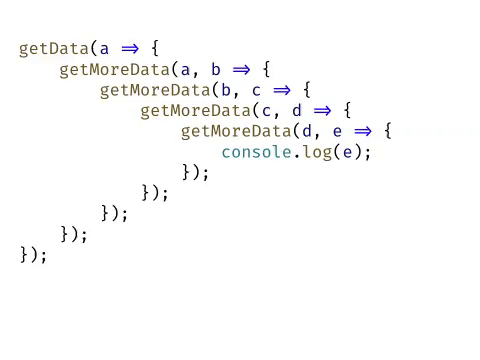JavaScript
Tools and Syntax
for the Modern Web
by Rob Richardson
About Me

Rob Richardson is a software craftsman building web properties in ASP.NET and Node, Angular and Vue. He's a frequent speaker at conferences, user groups, and community events, and a diligent teacher and student of high quality software development. You can find this and other talks on https://robrich.org/presentations and follow him on twitter at @rob_rich.
ES6, ES7, ES8+
So which is it?
JavaScript Harmony
EcmaScript 6
EcmaScript 2015
ES6
... they're the same thing
EcmaScript versions
| Version | Date | Features |
| 1 | 6/1997 | |
| 2 | 6/1998 | |
| 3 | 12/1999 | |
| 4 | Abandoned | |
| 5 | 12/2009 | strict mode, JSON, standards |
| 5.1 | 6/2011 | standards |
| 6 | 6/2015 | classes, modules, iterators, generators, arrow functions, typed arrays, collections, promises, let, const, Array methods, etc |
| 7 | 6/2016 | **, Array#includes |
| 8 | 6/2017 | async / await |
| 9 | 6/2018 | rest, spread, async loops |
source: wikipedia.org/wiki/ECMAScript
EcmaScript
... in the browser
The server-side ES story is interesting too,
but we'll focus on the browser story
EcmaScript 6
Two main groups of new things:
- New Features
- New Syntax:
sugar over existing features
Can I use it today?
Yes but ...
Browser support:
kangax.github.io/compat-table/es6/
www.caniuse.com
spoiler: Evergreen browsers will always lag, but you can "transpile" to older standards and use new things today
What is Transpiling?
Transpiling is a specific term for taking source code written in one language and transforming into another language that has a similar level of abstraction.
Source: https://www.stevefenton.co.uk/2012/11/compiling-vs-transpiling/
The Tools
Groups of Tools
- Polyfills: add missing methods at runtime
- Transpiler: convert newer to similar older code
- Bundler: polyfill module loading
Polyfills
Can I polyfill the feature?
HTML5 examples:
Yes: html5shiv adds Array methods and additional tags
No: Can't polyfill canvas tag
Transpilers
- Babel: babeljs.io
- TypeScript: typescriptlang.org
 Using Babel
Using Babel
- Visit babeljs.io/docs/setup/
- Choose your host
- Include the provided code
 Using Babel
Using Babel
- Visit babeljs.io/repl/
- Type stuff
Bundlers
- Browserify: browserify.org
- Webpack: webpack.js.org
- Rollup: rollupjs.org
 Using Webpack
Using Webpack
npm install --save-dev webpack-cli
npm install --save-dev webpack
webpack main.js -o bundle.jsThen reference bundle.js from your html
 Using Webpack
Using Webpack
webpack.config.js:
module.exports = {
entry: './main.js',
output: {
filename: 'bundle.js'
}
};$> webpackUsing Webpack with Babel
webpack.config.js:
module.exports = {
entry: './main.js',
output: {
filename: 'bundle.js'
},
module: {
rules: [
{
test: /\.js$/,
exclude: /node_modules/,
loader: 'babel-loader'
}
]
}
};.babelrc:
...Using Webpack with Babel
webpack.config.js:
....babelrc:
{
"presets": ["@babel/preset-env"]
}Then run these from the command line
npm install --save-dev babel-loader @babel/core @babel/preset-env
webpackBabel Presets
@babel/present-env
includes all the released features,
and transpiles to suport all active browsers.
Optionally configure target browsers using browserlist queries.
See also https://browserl.ist/
Babel Presets
To use stage-# features, include plugins for each feature.
stage-# presets are deprecated.
TC39 Process
- stage-0. Strawman: an idea
- stage-1. Proposal
- stage-2. Draft: Initial spec
- stage-3. Candidate: Complete spec, initial browser implementations
- stage-4. Finished: will go to next yearly release
Source: tc39.github.io/process-document/
Can I use it today?
Yes.
Use WebPack and Babel
to transpile an ES6/7/8 app into an ES5 file.
The Language
Cool Syntax
Sprinkle in sparingly.
Don't use it just to use it.
Use it when it adds clarity
and simplicity to your code.
Code for legibility
Code like the person maintaining your code is a homicidal maniac that knows where you live.
 Variable scoping
Variable scoping
ES5: var
function hello() {
console.log(message);
// undefined
if (true) {
var message = 'hello world';
console.log(message);
// 'hello world'
}
console.log(message);
// 'hello world'
}ES6: let, const
function hello() {
console.log(message);
// exception
if (true) {
let message = 'hello world';
console.log(message);
// 'hello world'
}
console.log(message);
// exception
} Variable scoping
Variable scoping
let and const
- scoped to curly braces, not to the function
 "fat arrow" functions
"fat arrow" functions
ES5: function
var array = [1,2,3];
array.map(function (a) {
return a * 2;
});ES6: =>
var array = [1,2,3];
array.map(a => a * 2); "fat arrow" functions
"fat arrow" functions
=>
- binds
thiswhen defined - always anonymous
- single line implicit last line return
- function is still best for heavy lifting
 "fat arrow" functions
"fat arrow" functions
Build it up
function (a) { return a * 2; }(a) => { return a * 2; }a => { return a * 2; }a => a * 2(a) => a * 2All of these are valid ES6 syntax
 "fat arrow" functions
"fat arrow" functions
Returning JS Object
function (a) { return {name: a}; }(a) => { return {name: a}; }a => {name: a} // <-- BROKENa => ({name: a}) Classes
Classes
ES5: constructor function
function Person(name) {
this.name = name;
}
Person.prototype.speak = function () {
console.log('hello '+this.name);
};ES6: class
class Person {
constructor(name) {
this.name = name;
}
speak() {
console.log('hello '+this.name);
}
} Classes
Classes
- Syntactic sugar over prototype chain
- It makes it feel like C# / Java
- ... it still works the same
Polyfill Promise
Asynchronous resolve
ES5: callback
function doWork(cb) {
cb(null, 'results');
}
doWork(function (err, results) {
if (err) {
// handle error
}
// handle success
});ES6: promise
function doWork() {
return new Promise(function (success, fail) {
success('result');
});
}
doWork().then(function (result) {
// handle success
}).catch(err) {
// handle error
});Polyfill Promise
Asynchronous resolve
- proxy for a later result
- alternate style to callbacks
- religious war: some find it more confusing
 Modules
Modules
import and export
- CommonJS module resolution
- resolves dependencies synchronously
- can reference only portions of the dependency
 Modules
Modules
ES5:
ES6: export and import
// -------- lib.js --------
export function square(x) {
return x * x;
}
// -------- main.js --------
import * as lib from './lib';
lib.square(4); // 16 Modules
Modules
Node:
// -------- lib.js --------
function square(x) {
return x * x;
};
module.exports = {
square: square
};
// -------- main.js --------
var lib = require('./lib');
lib.square(4); // 16
ES6: export and import
// -------- lib.js --------
export function square(x) {
return x * x;
}
// -------- main.js --------
import * as lib from './lib';
lib.square(4); // 16 Modules
Modules
Node:
// -------- lib.js --------
function square(x) {
return x * x;
}
module.exports = {
default: square
};
// -------- main.js --------
var lib = require('./lib').default;
lib(4); // 16ES6: export and import
// -------- lib.js --------
export default function (x) {
return x * x;
}
// -------- main.js --------
import lib from './lib';
lib(4); // 16 String Templates
String Templates
ES5: add strings
var a = 5;
var b = 10;
var msg = "Fifteen is " + (a + b) + " and\n";
message += "not " + (2 * a + b) + ".");
console.log(msg);
// "Fifteen is 15 and
// not 20."ES6: string templates
var a = 5;
var b = 10;
var msg = `Fifteen is ${a + b} and
not ${2 * a + b}.`;
console.log(msg);
// "Fifteen is 15 and
// not 20." String Templates
String Templates
- Use variables inline
- Multi-line strings
- Be careful to html encode user data
 Building objects
Building objects
- Syntactic sugar for declaring variables more easily
 Building objects
Building objects
ES5:
var x = 3;
var y = 7;
var c = {
x: x,
y: y
};ES6:
var x = 3;
var y = 7;
var c = { x, y }; Building objects
Building objects
ES5:
var x = 3;
var y = 7;
var c = {
x: x,
y: y,
z: 9
};ES6:
var x = 3;
var y = 7;
var c = {
x,
y,
z: 9
}; Dereferencing objects
Dereferencing objects
ES5:
var c = { x: 3, y: 7 };
var x = c.x;
var y = c.y;
console.log(x); // 3ES6:
var c = { x: 3, y: 7 };
let { x, y } = c;
console.log(x); // 3
 Dereferencing objects
Dereferencing objects
ES5:
ES6:
// -------- lib.js --------
export function square(x) {
return x * x;
}
export function double(x) {
return x * 2;
}
// -------- main.js --------
import { square, double } from './lib';
square(4); // 16
double(4); // 8 Rest parameters
Rest parameters
ES5:
function (a, b) {
var theRest = Array.prototype.slice.call(arguments);
theRest.shift(); // a
theRest.shift(); // b
theRest.forEach(function (g) {
// ...
});
}ES6:
function(a, b, ...theRest) {
theRest.forEach(function (g) {
// ...
});
} Rest parameters
Rest parameters
- Get the rest of the arguments passed as an array
- Must be the last argument
- Much better than "arguments" pseudo-array
 Spread operator
Spread operator
Pass an array like a series of arguments
ES5:
function myFunction(x, y, z) { }
var args = [0, 1, 2];
myFunction.apply(null, args);ES6:
function myFunction(x, y, z) { }
var args = [0, 1, 2];
myFunction(...args); Spread operator
Spread operator
- Turn array into a list of parameters
- Like apply() but doesn't change "this"
 Spread operator
Spread operator
A more powerful array literal
ES5:
var parts = ['shoulders', 'knees'];
// duplicate array
var lyrics = parts.slice();
lyrics.unshift('head');
lyrics.push('and');
lyrics.push('toes');
// ["head", "shoulders", "knees",
// "and", "toes"]ES6:
var parts = ['shoulders', 'knees'];
var lyrics = [
'head',
...parts,
'and',
'toes'
];
// ["head", "shoulders", "knees",
// "and", "toes"] Rest and Spread operators
Rest and Spread operators
A more powerful array literal
Rest:
function (a, b, ...theRest) {
theRest.forEach(function (g) {
// ...
});
}Spread:
var args = [0, 1, 2];
myFunction(...args); async / await
async / await
ES6: promises
function doWork() {
return new Promise(function (success, fail) {
success('result');
});
}
doWork().then(function (result) {
// handle success
}).catch(err) {
// handle error
});ES8: async / await
async function doWork() {
// something asynchronous
return 'result';
}
try {
let result = await doWork();
} catch (err) {
// handle error
} async / await
async / await
- Looks synchronous, acts asynchronous
- Promises under the hood
- Automatic interop with promises
 async / await
async / await

Source: bram.us/2017/05/09/javascript-from-callbacks-to-promises-to-asyncawait-in-7-seconds/
Cool Syntax
Remember: sugar over existing features
Sprinkle in sparingly to add legibility
Don't add new features to show off
Tools
| ES6,7,8+ -> ES5 |  babeljs.io babeljs.io |
| import and export |  webpack.github.io webpack.github.io |
| Anything else | Polyfill as needed |
Modern Frameworks
| React (create-react-app) |
Webpack & Babel with JSX plugin |
| Angular CLI | Webpack & TypeScript |
| Vue.js CLI | Webpack & Babel or TypeScript |
| Aurelia CLI | Webpack & Babel or TypeScript |
Yes!
You can use modern JavaScript today.